Types of Palm Fruits (With Pictures and Names) – Identification Guide
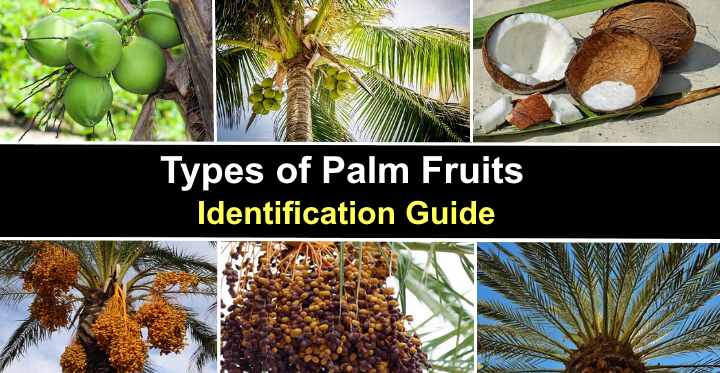
Palm fruits can be juicy, sweet, and exotic or tropical types of fruit. However, answering the question: “what type of fruit grows on palm trees?” can be tricky. There are many varieties of palms, each providing a unique type of palm fruit. The most recognizable types of palm fruits are dates and coconuts. Some other varieties of edible fruit from palm trees can be round black berries, brown oval drupes, or dark red to orange clusters of sticky fruits.
This article is a complete guide to 12 types of edible palm fruits. Some of these fruits may be commonly sold in local stores. Other types of palm tree fruits are processed and used in the food industry or as health supplements.
What Fruit Grows on Palm Trees?
The most common fruits that grow on palm trees are coconut and dates. Other types of fruits that grow on palm trees are acai berries, oil palm fruits, saw palmetto, jelly palm fruits, betel nuts, and round fruits like peach palms. Some palm tree fruits look like miniature coconuts called coquitos.
Palms are a group of perennial flowering woody plants in the family Arecaceae with around 2,600 species. Although often called a tree, botanically speaking, a palm is a woody, herbaceous plant like bamboo or bananas. However, large palms have a tree-like appearance.
The fruit that grows on palm trees is relatively diverse. For example, date palms are brown, red, or black drupes with a sweet, sticky, fleshy substance covering a hard stone. With dates, it’s the flesh that is edible.
However, coconut palm fruit is different. The white edible part of a coconut is part of the seed. Also, coir is the coarse fiber surrounding a coconut fruit seed used for making household items or as a substitute for peat moss.
People tend to avoid eating oil palm fruit. Instead, the fruit pulp and seeds are crushed to extract vegetable oil which is widely used in food and cosmetics production.
Palms don’t have leaves; instead, they have evergreen fronds that grow from an unbranched stem. The long, arching stems and an explosion of foliage of fan-shaped leaves on the top usually remind people of warm, tropical islands.
Related reading: Type of palm trees that grow in Florida.
Types of Palm Fruits (with Pictures) – Identification Guide
Let’s look in more detail at how to identify common types of palm fruit.
Coconut Palm Fruit (Cocos nucifera)
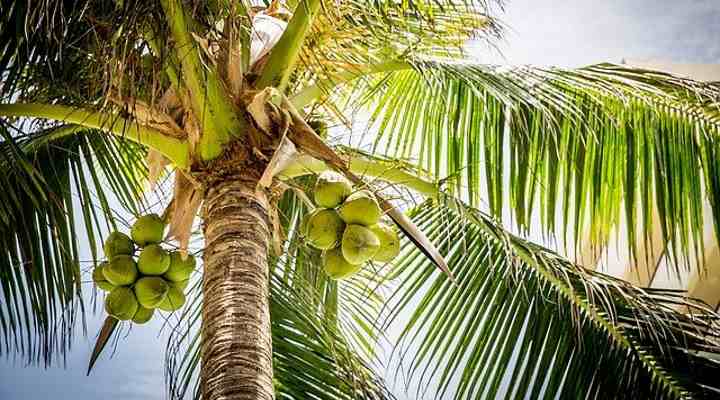
Coconut palm fruit is green or yellow when immature
The fruit of the coconut palm is a large green or yellow round fruit when immature, that can measure up to 8” (20 cm) in diameter and 18” (45 cm) long. The recognizable mature brown coconut seed is covered in a hairy fiber and is located inside a thick husk. A coconut weighs around 3 lbs. (1.4 kg).
Although referred to as a nut, the fruit from a coconut palm is a drupe, not a true nut. Drupes like dates, peaches, olives, and cherries, have a central stone or seed surrounded by a thick flesh (called a mesocarp).
Mature coconuts are easiest to identify because they are usually sold as large oval, brown hard nut-like fruit. The interior of the coconut has thick white flesh and clear liquid. Drilling through the soft part of a hard brown coconut reveals nutritious coconut water. The ‘meaty’ substance is used to produce coconut oil or is sliced, grated, or roasted and used in cooking.
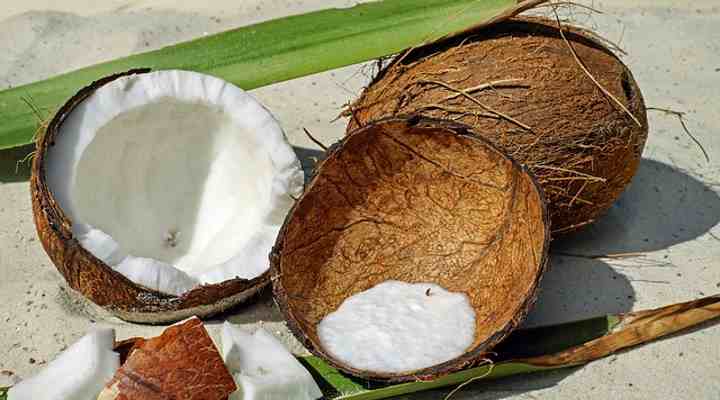
Mature fruit of coconut palm trees is identified by brown, hard and hairy fibrous shell
An immature coconut has a lighter greenish or yellowish color. You can spot clusters of coconuts growing high up on coconut palms. The roundish round fruit contains a liquid called coconut water, and a jelly-like substance called coconut meat. Typically, the top is sliced off green coconuts, and you can drink the coconut water straight from the fruit.
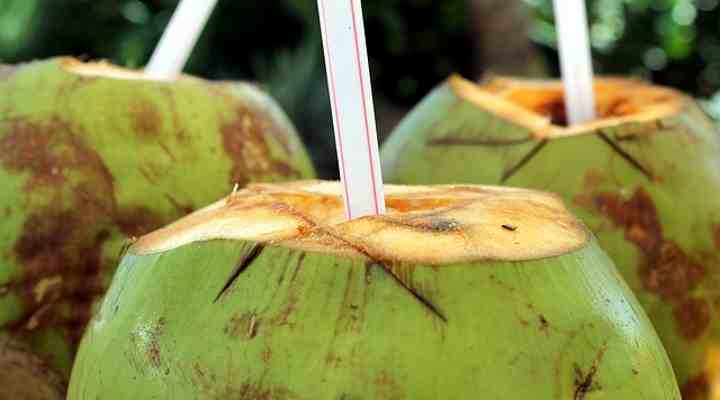
Drinking coconut water straight from the immature coconut fruit is a common sight in tropical areas
The shape of coconut palm fruit differs depending on whether it’s a domesticated type of coconut or a wild species. Pacific coconuts (domesticated) varieties have a round shape when growing on the palm tree. However, wild coconuts have an elongated, triangular shape.
Further reading: Types of Coconuts from Around the World.
Date Palm Fruit (Phoenix dactylifera)
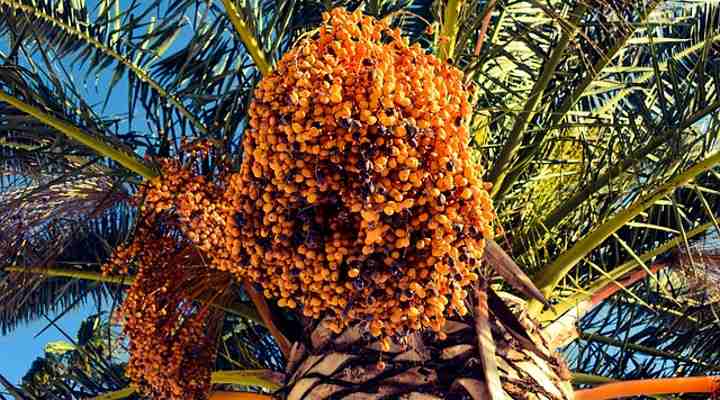
Date palm fruits grow in large clusters and can vary in color depending on the species
The fruit of the date palm tree is a relatively large, soft, oval drupe ranging in color from bright red to yellow or dark brown fruit. Brown dates with their fibrous flesh are the most recognizable type of date. The oval-cylindrical fruits measure 1” to 3” (2.5 – 7 cm) long.
Date palm fruit is easy to identify on a tall palm tree. The massive distinctive clusters of dates can measure up to 4 ft. (1.2 m) long. Depending on the climate and age of the tree, date palm trees can produce up to 200 lbs. (90 kg) of fruit a year.
The most common type of sweet date that is eaten is the Medjool date. This is also the largest type of date fruit. The oval dark brown or reddish-brown fruit has slightly wrinkled skin, sticky flesh, and a soft texture. The sweet fibrous flesh is delicious to eat ‘out-of-hand’ or chopped up in desserts or savory dishes.
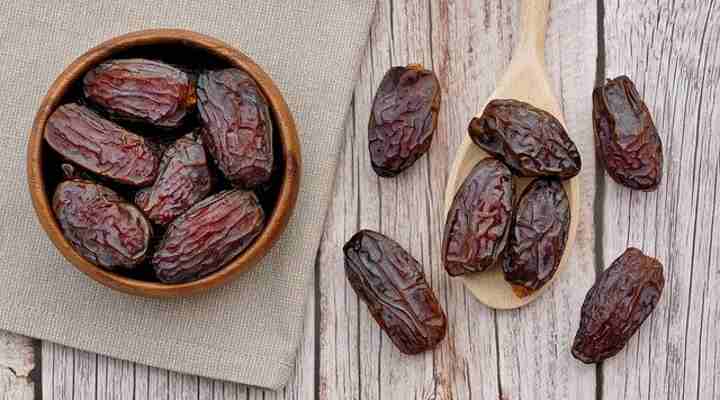
Medjool dates
Although typically classified as large brown fruit, there are many variations of date palm fruits. For example, Deglet Nour dates are dark brown with a honey-like taste. Sukkari dates have sweet golden yellow flesh that is mouth-watering soft and juicy. Ajwa dates have wrinkled black skin like a giant raisin, smooth flesh, and a rich, sweet taste.
Further reading: Types of Dates from Around the World.
Açaí Palm Fruit (Euterpe oleracea)
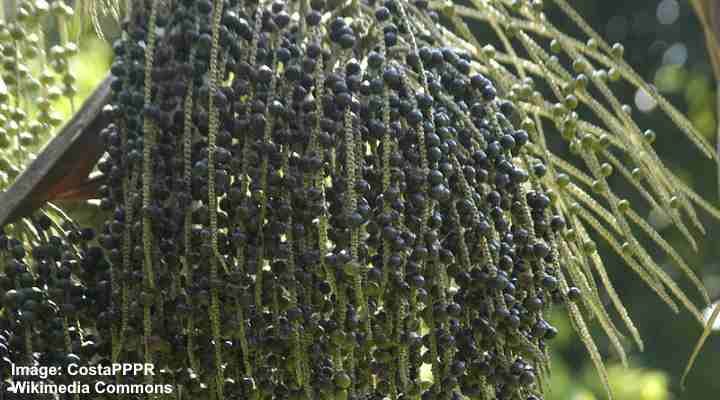
The fruit of the acai palm tree looks like black round berry
The fruit from the acai palm tree is a berry-like drupe that looks like a grape. The black, round acai berries grow in huge clusters with between 500 and 900 fruits on drooping branches. Black acai berries have pulpy flesh covering a single seed. The berries from acai palms measure 1” (2.5 cm) in diameter.
You can identify ripe acai palm fruit when the round berries turn a dark purple, almost black color. A feature of acai palm berries is that the seeds are proportionally large compared to the edible portion of the flesh. The taste of acai berries is described as tasting like blackberries and unsweetened chocolate with an earthy flavor.
Typically, you can’t find fresh acai berries outside their native South America because they have a short shelf life. However, due to their antioxidant capacity, acai berry supplements are sold for their purported health benefits. In addition, the oil from acai palm fruit is used in cosmetics.
Pindo Palm Fruit – Jelly Palm Fruit (Butia capitata)
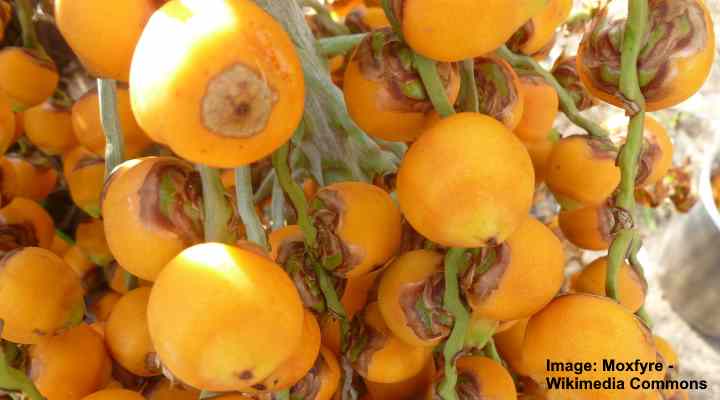
Pindo palm fruit is also called the jelly palm fruit and is orange/yellow
Fruit from the pindo palm tree is a small yellowish or orange palm berry about the size of a cherry. Also called the jelly palm fruit, the orange-yellow fruit measures approximately 1” (2.5 cm) in diameter. Like most fruit growing on palm trees, jelly palm fruit grows in enormous clusters.
The jelly palm tree gets its name from the high pectin levels in the round orange drupes. When eaten raw, jelly palm fruits taste like apricots or exotic pineapple and banana. Round, ripe jelly palm ‘berries’ are often made into a sweet, tart jelly.
Many homeowners in southern states such as Florida grow pindo palm trees as an ornamental landscape plant. However, the abundance of palm fruit can mean the tree is relatively messy. The yellow or orange palm fruit falls when ripe, and there are usually too many palm berries for a household to use.
Saw Palmetto Palm Fruit (Serenoa repens)
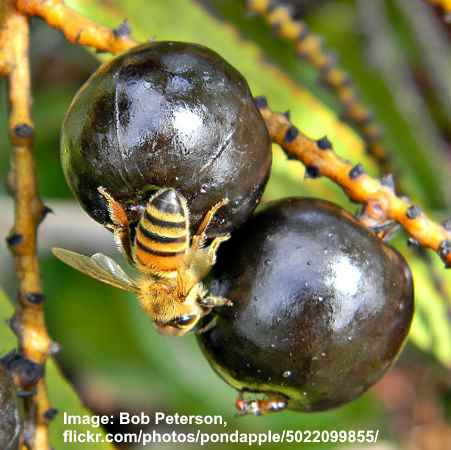
Saw palmetto is a small palm tree that produce black berry-like drupes
The fruit on saw palmetto palms is an identifiable oval dark or black berry that looks like an olive. Each black rounded fruit measures between 0.5” and 1” (1.3 – 2.5 cm) long and grows in dense clusters. The saw palmetto palm’s dark berries have a sweet aroma but have a strong blue cheese flavor.
Native to Florida, the saw palmetto fruit from this dwarf palm tree is oily like a black olive. However, because of its pungent taste, the purpulish-black palm fruit is rarely used in cooking.
The most common use for saw palmetto berries is in their dried form. The dried berries are made into a powder and sold as a male health supplement.
Peach Palm Fruit (Bactris gasipaes)
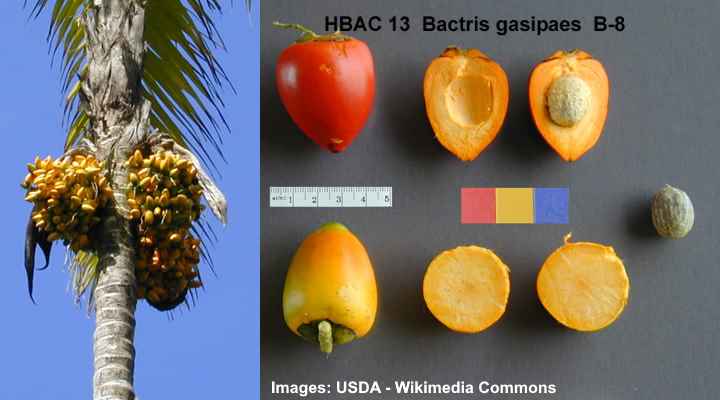
Peach palm fruit can be red, yellow, or orange, depending on the palm variety
The fruit from the peach palm is a large orange, red, or yellow edible drupe with a triangular shape. Peach palm fruit is easy to identify growing on a palm tree. Each fruit measures 2.4” (6 cm) long and 2” (5 cm) wide, and the fleshy fruits grow in drooping clusters.
Peach palm fruits can number up to 300 fruits on each bunch. Depending on the tree’s age, up to five clusters of ovoid-shaped orange or red fruits grow on a single palm tree. The large bunches of palm fruit can weigh up to 26 lbs. (12 kg).
Oil Palm Fruit (Elaeis guineensis)
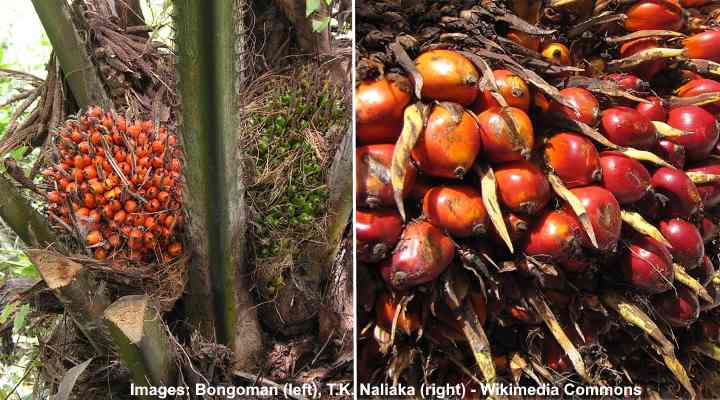
Oil palm fruits are orange or red and are commonly used in oil production
The fruit that grows on an oil palm tree is a large orange to dark red rounded fruit. Like most palm trees, the round fruits grow in massive clusters. Each red palm fruit has an oily flesh and oil-rich seed or kernel. Each bunch of oil palm fruits can weigh between 11 and 66 lbs. (5 – 30 kg).
The most common use of oil palm fruit is in vegetable oil production. Oil is pressed from the palm fruit, extracting the valuable substance from the pulp and kernel. It is estimated that 220 lbs. (100 kg) of the pulp can produce 48 lbs. (22 kg) of vegetable palm oil and 3.5 lbs. (1.6 kg) of palm kernel oil.
Betel Nut Palm Fruit (Areca catechu)
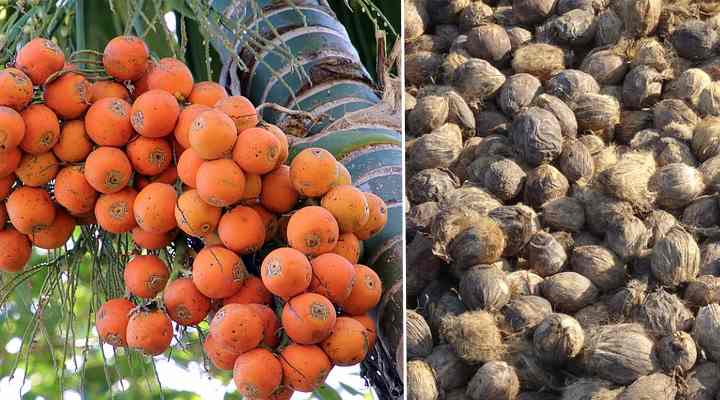
Immature betel nut palm fruit (left) and mature fruit (right)
The fruit from the betel nut palm tree is the areca nut. The mature palm nuts are brown and egg-shaped and measure up to 2” (5 cm) long. Although called a nut, this brown palm fruit is a hard-shelled drupe. When ripe, the outer layer develops a hard, fibrous shell like a nut.
The areca palm nut is commonly called the betel nut. This is because, in Southeast Asia, the areca palm fruit is chewed along betel leaf for its stimulating effects. However, chewing areca nut along with betel leaf is linked to severe side effects and disease.
Snake Palm Fruit (Salacca zalacca)

Snake palm fruit has a scaly snake-like brown skin covering white pulp
The fruit growing on the snake palm is an egg-shaped brown, about the size of a fig, with sweet and tangy white edible pulp inside. Snake palm fruit consists of three lobes that are like a garlic bulb. Each of the lobes contains a large inedible seed.
Fruit from a snake palm gets its name from the brown, scaly skin covering the large fruit. Biting into the white firm pulp has a texture like an apple. However, the taste of snake palm fruit can be from sweet to astringent. Sometimes, the palm fruit is moist and crunchy; other times, it’s dry and crumbly.
Also called the snakeskin palm or salak tree, snake fruit grows in Java and Sumatra in Indonesia.
Chilean Wine Palm Fruit (Jubaea chilensis)
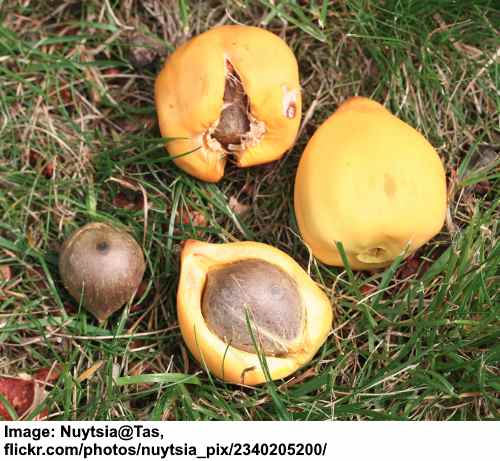
Chilean wine palm fruit is also known as coquito
Fruit from the Chilean wine palm tree is a round, spherical yellow or brown fruit and looks like a tiny coconut. The small round palm fruit measures 0.8” to 1.2” (2 – 3 cm) in diameter. The small coconut-like fruits have a hard outer shell that covers creamy white flesh. Although the round palm fruits are edible, they have a soapy, unappetizing taste.
Chilean wine palms get their name from the tree sap used to make palm syrup or palm wine. However, to get the sap, it’s necessary to chop down the palm tree. Because the species is threatened, chopping down Chilean wine palms is restricted.
Guadalupe Fan Palm Fruit (Brahea edulis)
Fruit from the Guadalupe fan palm is round and golden yellow, measuring 1” to 1.5” (2.5 – 3.8 cm) in diameter. The round palm fruits have sweet flesh that is reminiscent of dates. The sticky pulp surrounds a hard seed in the center, making this palm fruit a true drupe.
You can eat Guadalupe fan palm fruits fresh off the tree or cooked as a sweet preserve.
California Fan Palm (Washingtonia filifera)
Fruit from the California fan palm tree is a small, rounded fruit growing in dense clusters. The small black, brown, or yellow palm fruits are drupes measuring 0.23” to 0.4” (0.6 – 1 cm) in diameter. Although California palm fruit is sweet and tasty, the edible portion is tiny compared to the hard seed in the middle of the soft pulp. Another name for Washingtonia filifera is desert fan palm.
Related articles:
